Boomers drive change in senior living
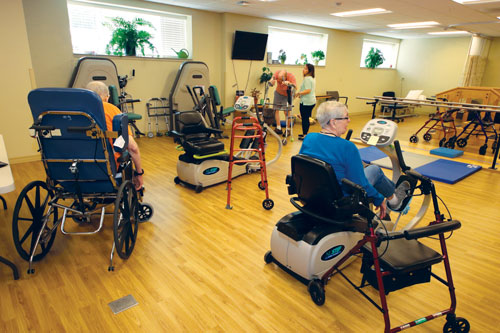 The therapy room in the Garrett Health & Wellness Center, built in 2017 by Carl A. Nelson & Company on the United Presbyterian Home campus in Washington, Iowa. (Carl A. Nelson & Company photo)
The therapy room in the Garrett Health & Wellness Center, built in 2017 by Carl A. Nelson & Company on the United Presbyterian Home campus in Washington, Iowa. (Carl A. Nelson & Company photo)
6 years ago
For owners of independent, assisted and long-term care housing facilities, it's time to think about building for the golden years
By Craig Neises | Carl A. Nelson & Company
By the year 2060, according to Census Bureau projections cited in a July report by the nonprofit Population Reference Bureau (PRB), there will be 95 million Americans age 65 or older. That number will amount to an estimated 23 percent of the United States population.
Dealing with the impacts of an aging population isn’t a challenge only for the future, though.
It’s a present-day reality already being experienced across the U.S., which was home in 2018 to 52 million people who could be classified as senior citizens.
“The current growth of the population ages 65 and older, driven by the large … baby boom generation, is unprecedented in U.S. history,” PRB stated in a 2019 update to its 2015 report, “Aging in America.” “As they have passed through each major stage of life, baby boomers (between ages 55 and 73 in 2019) have brought both challenges and opportunities to the economy, infrastructure, and institutions.”
Those include, according to PRB, greater racial and ethnic diversity among the elderly population, but also wider economic disparities among racial and ethnic groups. Longer lifespans, longer work lives and a shrinking longevity gender gap are balanced by a greater strain on Social Security and Medicare, increased demand for Alzheimer’s care and a possible 50 percent increase in the number of Americans requiring nursing home care: up from 1.2 million in 2017, to 1.9 million by 2030.
Amid looming demographic change, many Americans are determined to age in place. For some, that will mean continuing to live independently in the home where they raised their families, while others will look for an independent living community. Those needing a little more help may choose to enter assisted living, while seniors needing the most care will continue to seek long-term nursing home care. Seattle-based retirement and senior living firm Leisure Care, in a January 2018 blog post, said no matter where they end up living, aging baby boomers are driving change within the senior living industry.
Longer lifespans mean boomers want to live in places where they can have a continuum of care – meaning independent living, assisted living and long-term care in a single community setting. It also means recreational options, easy access to WiFi for their devices and easy access to resources like healthcare, shopping, dining and community events, Leisure Care said.
Across that range of needs and preferences, Carl A. Nelson & Company (CANCO) has experience helping long-term care and senior living providers meet the needs of seniors as part of a circle of community-based healthcare options.
“In some cases, our healthcare clients are expanding or replacing their senior living facilities,” said CANCO Vice President of Construction Chris Smith. “Many of these facilities are wanting all-inclusive healthcare campuses that range from independent living, assisted living, skilled care nursing homes, hospital and hospice.”
In Stronghurst, Illinois, an addition to Oak Lane Nursing and Rehabilitation, dubbed Oak Wood Estates Retirement Village, provides an assisted living option for residents of the rural community of fewer than 1,000 people. United Presbyterian Home (UPH) in Washington, Iowa, offers senior accommodations that range from skilled nursing to assisted and independent living in apartment or stand-alone cottage settings. In 2017, UPH expanded its range of options and services by adding a 17-bed assisted living facility and wellness center.
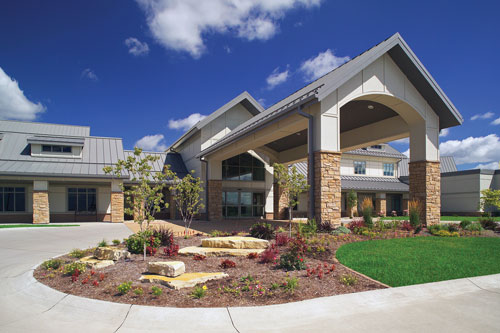
Klein Center, a 160-bed long-term and skilled nursing facility in West Burlington, Iowa, was built by Carl A. Nelson & Company in 2013. (Dale Vandenselaar photo)
And on the campus of Great River Health System (GRHS) in West Burlington, Iowa, Klein Center was built in 2013 by CANCO as a 160-bed long-term care, skilled nursing and memory care facility that bears little resemblance to what Leisure Care called the “sterile retirement communities of yesterday.”
At Klein Center, visitors approach a building that is anything but institutional in appearance, with its peaked roof, covered entrance, stone-accented columns and brick-accented façade. Inside the lobby is a vaulted ceiling and large windows that drench the space with natural light. Known as Town Center, it includes a coffee shop, honor wall for residents who served in the military, a beauty salon and a gathering room that serves as both chapel and activity space.
“I get compliments all of the time about how beautiful this building is,” said Klein Center Administrator Ann Abolt.
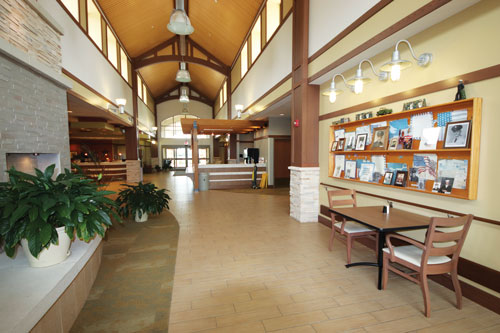
The lobby area at Klein Center, dubbed Town Center, includes an honor wall for residents who served in the military, along with a beauty salon and coffee shop. (Carl A. Nelson & Company photo)
Six years after completion of construction, GRHS Director of Facilities John Mercer remains happy with the outcome.
“The new building is working out fantastically from a low-maintenance and operational cost perspective,” he said. “The utility cost of the new building is half of what the old building was with the geothermal system and LED lighting upgrades.”
With its track record in healthcare construction, CANCO had the confidence of GRHS to build its new long-term care facility. Mercer cited the company’s experience, along with a shared desire between the builder and owner to be “great stewards of the hospital’s resources,” as a reason GRHS was able to realize $660,000 in savings from the project’s $31 million guaranteed maximum price.
Jordan Hutcheson, a field engineer at CANCO who oversaw completion of the new facility at UPH, said there are several key aspects that have to be kept in mind when constructing a senior living facility that an experienced builder can help to identify. Like knowing certain models of wheelchair-accessible showers have to be accounted for before concrete is even poured. Considering how residents will use their rooms also is important when planning mechanical, electrical and plumbing systems for units, so the placement of outlets, vents and plumbing fixtures don’t create issues with livability.
“If you’re not thinking ahead of time about the function of the space,” Hutcheson said, “then there will be important details that you’ll miss that will be difficult to correct later.”
Klein Center’s residential rooms – more than half of which are equipped with overhead lifts, and all of which are handicapped accessible – are divided among 10 “houses” of 16 rooms apiece (two houses make up a neighborhood), where residents each enjoy private accommodations but come together for meals, social time and activities in shared spaces.
“It’s a very small community and they become very close-knit, along with their families,” Abolt said, describing the living environment. “Because there is a small number of elders in a house, the dining atmosphere is very calm, which allows elders to be less distracted by what is going on and they can focus on eating.”
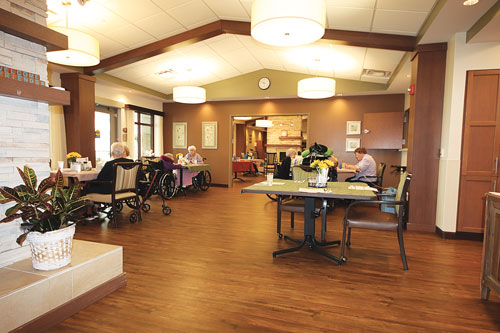
Each of the 10 houses inside Klein Center, consisting of 16 private rooms each, has its own dining space. (Carl A. Nelson & Company photo)
Among the 160 beds, there are 112 presently devoted to long-term care, while there are 16 beds reserved for skilled nursing, and 32 in the memory care unit. And those numbers are not locked by design into a single type of use.
“The great thing about our building is that each house is identical in the layout, so if we need to add more beds of Alzheimer’s care, we could do that,” Abolt said. “If we needed to add more beds for skilled nursing facility care, we could do that. Our building layout allows us to add or delete beds very easily.”
The building layout addresses another potential need as well: additional space. Abolt said she anticipates Klein Center will be at-capacity in the future, with Iowa already having more seniors than long-term care beds to serve them. When the building was being designed, plans were made to accommodate a possible 32-bed addition.
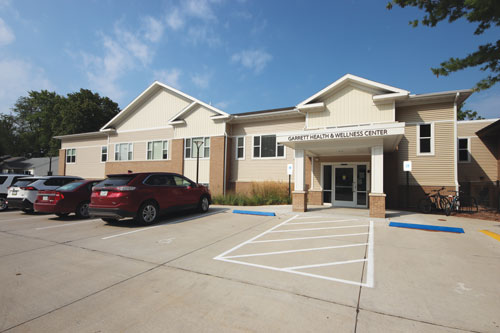
The Garrett Health & Wellness Center, built in 2017 by Carl A. Nelson & Company on the United Presbyterian Home campus in Washington, Iowa. (Carl A. Nelson & Company photo)
At UPH in Washington, Iowa, the addition of 17 apartments – each dual-certified for long-term and skilled care – in a household-style residential unit was driven by a desire to increase the number of private rooms without sacrificing the overall number of beds, CEO Erin Drahota said. The result was the Garrett Health & Wellness Center.
“It has been a wonderful addition to our campus, both in offering a much larger number of private rooms,” Drahota said, noting an increase from 20 to 47 private living spaces, “and in creating functional spaces to house our already successful programs.”
The two-story building includes the assisted living unit on the upper story, which placed it on the same level as an adjacent skilled nursing facility. The addition has a homelike feel, she said, and features a kitchen that is staffed 12 hours a day to suit residents’ schedules. The common areas also are open to residents and families in other parts of the campus, who come to enjoy the fireplace, have some ice cream or participate in an activity.
“The household model has been around for many years, so it was a good opportunity for our community to catch up with that style,” Drahota said. “The other piece of our addition was the opportunity to design a wellness center that was spacious and cohesive.”
.jpg)
A resident plays solitaire and watches television in his room at the Garrett Health & Wellness Center. The 17-room assisted living unit on the building's upper story introduced the household concept to the United Presbyterian Home campus. (Carl A. Nelson & Company photo)
Wellness services had been offered by UPH for 20 years, but those services had been spread out around the building, and not always in the most suitable spaces. The 10,000-square-foot wellness center on the ground floor of the Garrett building, Drahota said, allowed UPH to consolidate its wellness and therapy services in an environment that appeals not only to residents but to members of the surrounding community age 55 and older who make use of physical, occupational and speech therapy services. The state-of-the-art fitness center features a full range of modern cardio and other exercise equipment. There is also a fitness studio for things like yoga classes, and a walking track.
“Wellness and therapy share a warm water therapy pool,” Drahota said, “which we use for individual therapy, aquatic classes and individual fitness, which has been a huge advantage to our members.”
UPH chose CANCO as its construction management at-risk partner for the project based on satisfaction with previous work performed by the company on the UPH campus, Drahota said. She said the company’s site team were “knowledgeable, productive and respectful during their time on our campus,” while working hard not to intrude any more than necessary on the lives of residents. They even, she said, “took the time to answer questions and get to know our residents who were interested in the project.”
CANCO, she added, “had a vested interest in keeping our project on-budget, and did so very well.”
In Stronghurst, Illinois, Oak Lane Nursing and Rehabilitation made an investment in its future by adding an adjacent 10-unit assisted living facility for people age 65 and older who need assistance with the tasks of daily living, such as meals and medications.
Oak Wood Estates Retirement Village administrator Bobbi Tapscott said when the decision to proceed with construction was made, it was because the nursing home had a waiting list. Also, she said, a need existed to accommodate more couples with double rooms. By late summer, three of the six double rooms and two of the four single rooms were occupied.
Hired to provide design-build services after previously leading construction of a physical therapy room, CANCO was able to help keep the project within a tight budget by working directly with local contractors and recommending pre-construction changes like updating a generator. Agreeing to pull kitchen cabinets from the bid documents so the owner could source them directly, Tapscott said, also provided “significant savings.”
The addition will help the community keep pace with senior living needs, providing for amenities like communal spaces and WiFi demanded by baby boomers, as well as a continuum of care with side-by-side access to assisted living and skilled nursing care, Tapscott said. For people still enjoying the freedom to come and go as they choose, she said features like personal patios, larger kitchenettes, a game room and three-season patio gives would-be residents an alternative to staying in their homes, where they would not necessarily also have the benefit of access to 24-hour care.
Spaces for group activities will become ever-more important in the senior living landscape, Tapscott said, explaining: “baby boomers are very social and will want to continue with the lifestyle they are accustomed to.”
Klein Center’s Abolt agreed that continuum of care options will become more significant in the future, and is something Burlington, Iowa, now lacks from a single provider. As the long-term care provider of choice in its community, though, she said Klein Center likely won’t be affected and will stay full “once the baby boomers start flooding into long-term care.”
Those baby boomers will have an impact in other ways, however, and Abolt believes Klein Center is ready.
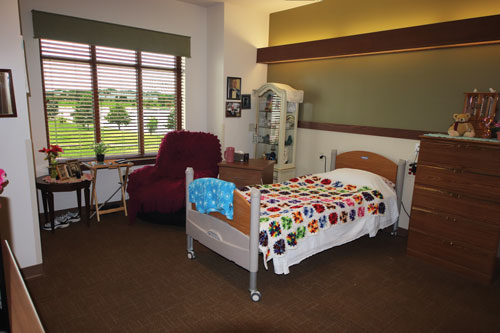
One of the 160 private rooms at Klein Center in West Burlington, this one looking out over the lake on the Great River Health System campus. (Carl A. Nelson & Company photo)
“They will not tolerate sharing a room with someone they don’t know like the generation we currently have,” Abolt said, noting Klein Center’s all-private accommodations. “They will be more tech savvy, and we have put things in place for that here in each of the rooms – as many of our current elders have laptops, PCs, iPads and cellphones.”
“Our building is set up for the boomer generation, but the kind of care will be different, and an adjustment for staff,” she added.”
Like her counterparts at Klein Center and Oak Wood Estates, UPH’s Drahota agreed facilities will be a key factor informing the choice of people looking for independent, assisted-living and long-term care options. She said reputation for quality will only matter so much if the rooms are only semi-private. Whether in their home or in a retirement community, the goal for aging in place is to provide in-home care and services that will help people remain independent for as long as possible, Drahota said. Boomers are likely to opt to stay in their homes longer than in previous generations, but amenities like the fitness center in the Garrett Health & Wellness Center “do drive people to move from the community to our campus.”
Facilities and amenities are only part of the package, however. Activities are crucial, too.
“The days of BINGO and Lawrence Welk,” Drahota said, “are being replaced with bean bag tournaments and tailgate parties.”